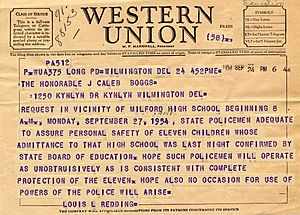Louis L. Redding facts for kids
Quick facts for kids
Louis L. Redding
|
|
|---|---|
| Born | October 25, 1901 |
| Died | September 28, 1998 (aged 96) |
| Nationality | American |
| Education | Brown University |
| Occupation | Lawyer |
| Known for | Civil rights |
| Relatives | J. Saunders Redding (brother) |
Louis Lorenzo Redding (born October 25, 1901 – died September 28, 1998) was a very important lawyer. He fought for civil rights in Wilmington, Delaware. He was the first African American lawyer allowed to practice law in Delaware.
Redding was also part of the legal team for the NAACP. This team challenged school segregation in the famous Brown v. Board of Education case. This case went all the way to the U.S. Supreme Court. He passed away at 96 years old in Lima, Pennsylvania.
Contents
Early Life and Education
Louis Redding was born in Alexandria, Virginia. His parents were Lewis Alfred Redding and Mary Ann (Holmes) Redding. His family moved to Wilmington, Delaware when he was a child. They lived in the heart of Wilmington's African-American community.
Louis went to public schools that were segregated, meaning Black and white students went to separate schools. He graduated from Howard High School in 1919. At that time, Howard High was the only high school for African Americans in Delaware.
After high school, he went to Brown University. He was a very good speaker and won an award for his speech about Booker T. Washington. He graduated from Brown with honors in 1923.
Later, Redding taught at schools like Fessenden Academy in Florida and Morehouse College in Atlanta, Georgia. In 1925, he started studying law at Harvard Law School. He was the only African American in his graduating class in 1928. The next year, he was allowed to practice law in Delaware.
In 2009, his childhood home in Wilmington, Delaware was opened as the Redding House Museum.
Fighting for Justice
Louis Redding started his law career in Delaware in 1929. He was the first African American lawyer in the state. For more than 25 years, he was the only non-white lawyer there.
Redding took on many cases that fought against unfair treatment. He challenged discrimination in housing, public places, jobs, and the justice system.
Ending Segregation in Schools
Redding worked on several important cases in Delaware to end segregation. In 1950, he took the University of Delaware to court. The university did not allow Black students to enroll. They used the "separate but equal" idea to justify this.
The court decided in favor of Redding's clients. This meant the University of Delaware had to admit Black students. It was the first state-funded college to end segregation because of a court order.
In 1952, Redding brought two more cases to court. These cases aimed to desegregate public schools in Claymont, Delaware and Hockessin, Delaware. These cases, Belton v. Gephart and Bulah v. Gephart, were combined. They became part of the huge U.S. Supreme Court case in 1954 called Brown v. Board of Education.
Redding argued the Brown case with a team of lawyers, including Thurgood Marshall. This landmark case made school segregation illegal across the United States.
Ending Segregation in Public Places
Redding also successfully argued the case Burton v. Wilmington Parking Authority in front of the U.S. Supreme Court in 1961. This case ruled that segregation in public places was not allowed.
Louis Redding practiced law for 57 years. His work helped open doors to education and public places for many people in Delaware and across the country.
After he passed away in 1998, the University of Delaware created a special position in his honor. A residence hall at the University of Delaware was also named after him in 2013. In 2016, a historical marker was put up to teach future generations about his important work.
Family Life
Louis Redding was the oldest of seven children. His brother, J. Saunders Redding, became a well-known author and college professor. His sisters, Lillian Redding Bailey and C. Gwendolyn Redding, were teachers in Wilmington. Sadly, two of his siblings died when they were children. Another sister passed away during her college years.
Louis Redding was married twice. He had three daughters, Ann, Rupa, and Judith, with his first wife, Ruth Albert Cook Redding. After they divorced, he married Gwendolyn Carmen Kiah.
See also
- List of first minority male lawyers and judges in Delaware


